Characterization of Ice Cream: Techniques and Components
This research paper discusses the characterization of ice cream, including factors such as fat content, aroma, and smoothness, and the techniques used to enhance its quality.
29 Pages6048 Words304 Views
Added on 2023-06-11
About This Document
This paper discusses the techniques and components used in characterizing ice cream to enhance its overall quality. The Babcock method is explored as a scientific engineering technique for determining the percentage content of fat in ice cream. The physical characteristics of ice cream, its components, and the advantages and disadvantages of the direct technique are also discussed.
Characterization of Ice Cream: Techniques and Components
This research paper discusses the characterization of ice cream, including factors such as fat content, aroma, and smoothness, and the techniques used to enhance its quality.
Added on 2023-06-11
ShareRelated Documents
CHARACTERIZATION OF ICE CREAM
By Name
Course
Instructor
Institution
Location
Date
By Name
Course
Instructor
Institution
Location
Date
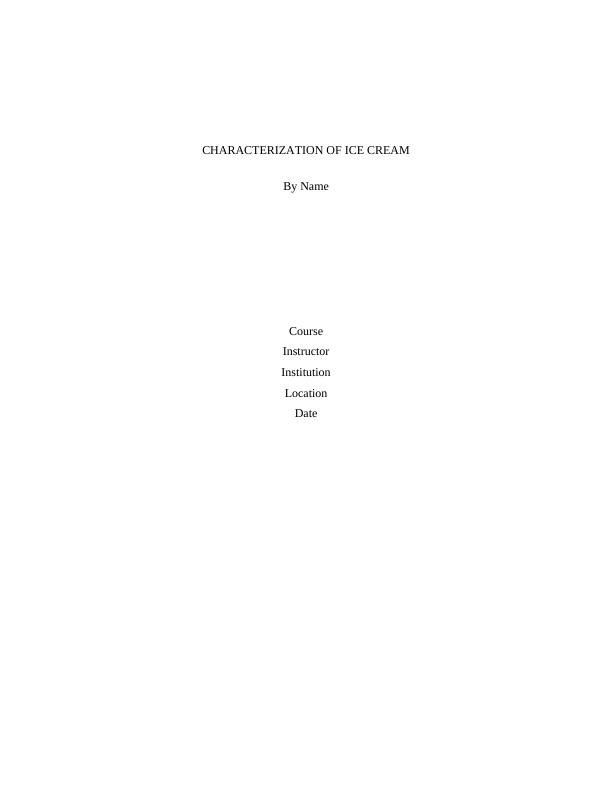
2
CHARACTERIZATION OF ICE CREAM
INTRODUCTION
The manufacturing of ice cream involves various processes. These processes, such as
freezing, are vital in determining desirable aspects of the ice cream like its overall texture. These
aspects inform what ice cream brand a customer purchases. Therefore, manufacturers are
normally keen on having the best processes to produce the highest quality ice cream that satisfy
the market demands.
Ice cream is a popular aerated dessert which is frozen. However, this dessert contains
high quantities of fat which can result in adverse health effects on a person. The ice cream
manufacturers therefore try hard to come with designs that have low fat contents without altering
the taste and sweetness of the ice cream. Hence, various methods or techniques are used in the
process of characterizing the ice cream to enhance the final performance such as the fat content,
aroma, and smoothness. This paper discusses some of the characterization techniques which are
applied in ensuring that the overall quality of ice cream is as desired (Aboulfazali et al, 2015).
CHARACTERIZATION OF ICE CREAM
INTRODUCTION
The manufacturing of ice cream involves various processes. These processes, such as
freezing, are vital in determining desirable aspects of the ice cream like its overall texture. These
aspects inform what ice cream brand a customer purchases. Therefore, manufacturers are
normally keen on having the best processes to produce the highest quality ice cream that satisfy
the market demands.
Ice cream is a popular aerated dessert which is frozen. However, this dessert contains
high quantities of fat which can result in adverse health effects on a person. The ice cream
manufacturers therefore try hard to come with designs that have low fat contents without altering
the taste and sweetness of the ice cream. Hence, various methods or techniques are used in the
process of characterizing the ice cream to enhance the final performance such as the fat content,
aroma, and smoothness. This paper discusses some of the characterization techniques which are
applied in ensuring that the overall quality of ice cream is as desired (Aboulfazali et al, 2015).
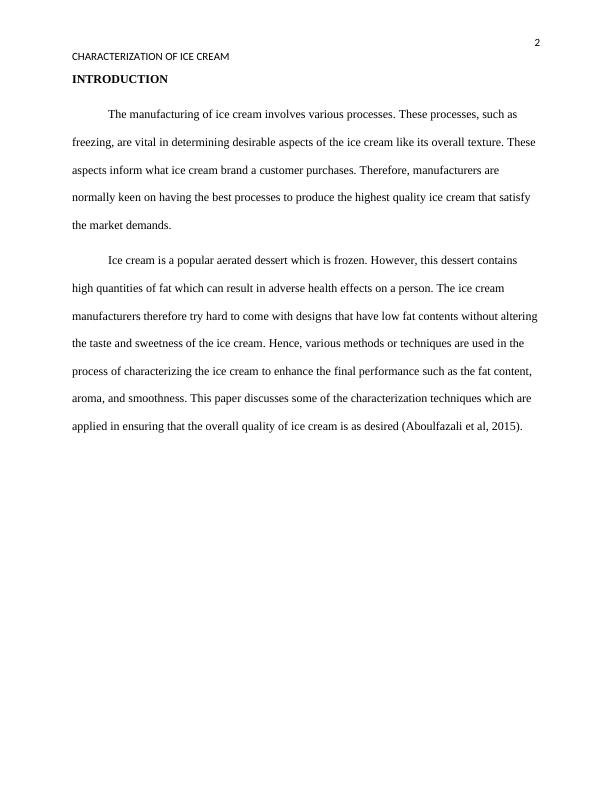
3
CHARACTERIZATION OF ICE CREAM
A. WHY ICE CREAM IS A FORMULATED PRODUCT
The physical characteristics of ice cream makes it a formulated product. Ice cream is composed
of various ingredients which are selected, processed and combined in a specific way to produce
the end product. The ingredients are combined in different proportions to achieve the different
specifications for the different ice cream varieties. The proportions are also carefully calculated
to maintain the other aspects of the ice cream.
Ice cream is made up of water, milk, cream, sugar and other flavoring additives combined in
different proportions. These additives in addition to giving the ice cream flavor, help maintain
the physical nature and the stability of the frozen structure when combined in a pre-defined ratio
(Aboulfazali et al, 2016). This is crucial in making sure the ice cream is neither too liquid nor too
solid, thereby attaining the perfect rigidity for the ice cream which is normally when the ice
cream temperature is between 5 degrees Celsius and 10 degrees Celsius.
Ice cream is a formulated product since it is produced by mixing different proportions of the
various ingredients following a given procedure that satisfies the grade and quality of ice cream
that is desired.
The concentration of different components in the ice cream for the standard brands include the
following:
Milk Fat – 10% to 16%
Milk Solids Not Fat (MSNF) - 9% to 12%
Sweeteners, Emulsifiers and Stabilizers– 13% to 17%
Overrun – 100% to 120% (Aime et al, 2009)
CHARACTERIZATION OF ICE CREAM
A. WHY ICE CREAM IS A FORMULATED PRODUCT
The physical characteristics of ice cream makes it a formulated product. Ice cream is composed
of various ingredients which are selected, processed and combined in a specific way to produce
the end product. The ingredients are combined in different proportions to achieve the different
specifications for the different ice cream varieties. The proportions are also carefully calculated
to maintain the other aspects of the ice cream.
Ice cream is made up of water, milk, cream, sugar and other flavoring additives combined in
different proportions. These additives in addition to giving the ice cream flavor, help maintain
the physical nature and the stability of the frozen structure when combined in a pre-defined ratio
(Aboulfazali et al, 2016). This is crucial in making sure the ice cream is neither too liquid nor too
solid, thereby attaining the perfect rigidity for the ice cream which is normally when the ice
cream temperature is between 5 degrees Celsius and 10 degrees Celsius.
Ice cream is a formulated product since it is produced by mixing different proportions of the
various ingredients following a given procedure that satisfies the grade and quality of ice cream
that is desired.
The concentration of different components in the ice cream for the standard brands include the
following:
Milk Fat – 10% to 16%
Milk Solids Not Fat (MSNF) - 9% to 12%
Sweeteners, Emulsifiers and Stabilizers– 13% to 17%
Overrun – 100% to 120% (Aime et al, 2009)
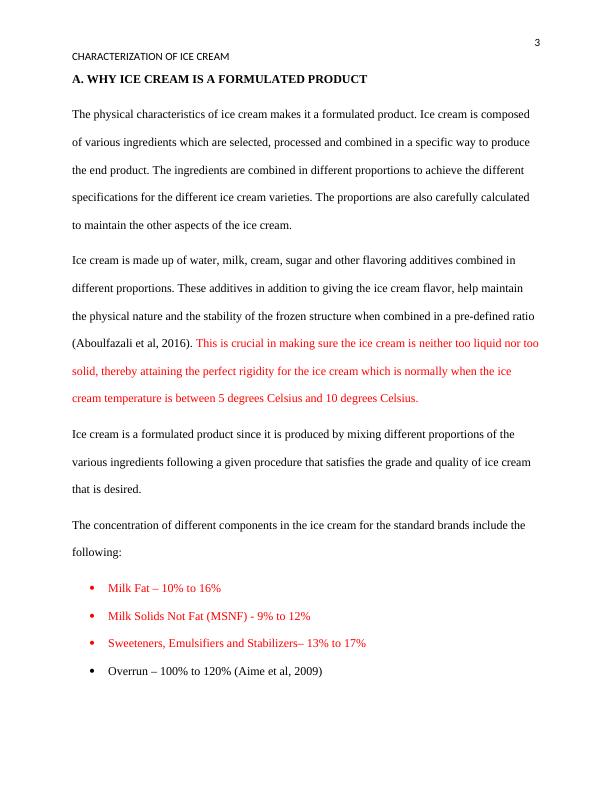
4
CHARACTERIZATION OF ICE CREAM
The nature of ice cream makes it a foam and emulsion simultaneously. It consists of a dispersion
of microscopic particles that are less than 0.5mm in size superimposed on one another. The air in
the ice cream does not combine with the other ingredients of the ice cream. This air forms the
small bubbles called the foam.
The ice cream has emulsifiers as well. These are the particles sticking to the interfaces of ice
cream preventing its structure from collapsing. The emulsifiers therefore are the ones that
maintain the stability of the ice cream’s structure.
Ice cream also contains dissolved substances that alter its freezing temperature. This results in
the ice cream’s freezing point being different from that of water. The presence of these solute
components is the reason for this increased range of temperatures from the onset to the actual
occurrence of the freezing process (Arbukule, 2009).
The Components of Ice Cream
The components of ice cream are primarily frozen emulsions of five basic ingredients. These are:
Ice Crystals- these are the frozen water component of the ice cream. They are formed by putting
the ice in the ice cream container when the base part of the water content starts to freeze thereby
giving the ice cream its solidity and body. The texture of the ice cream is determined by the size
of the crystals, that is, how fine or grainy is the final ice cream. For this reason, one should aim
more at regulating the size of the ice grains so that it is maintained as small as possible (Boff et
al, 2013). This is however subject to the specifications and desired ice cream type. Regulating
the ice crystals to the desired size produces ice cream with the specified texture.
CHARACTERIZATION OF ICE CREAM
The nature of ice cream makes it a foam and emulsion simultaneously. It consists of a dispersion
of microscopic particles that are less than 0.5mm in size superimposed on one another. The air in
the ice cream does not combine with the other ingredients of the ice cream. This air forms the
small bubbles called the foam.
The ice cream has emulsifiers as well. These are the particles sticking to the interfaces of ice
cream preventing its structure from collapsing. The emulsifiers therefore are the ones that
maintain the stability of the ice cream’s structure.
Ice cream also contains dissolved substances that alter its freezing temperature. This results in
the ice cream’s freezing point being different from that of water. The presence of these solute
components is the reason for this increased range of temperatures from the onset to the actual
occurrence of the freezing process (Arbukule, 2009).
The Components of Ice Cream
The components of ice cream are primarily frozen emulsions of five basic ingredients. These are:
Ice Crystals- these are the frozen water component of the ice cream. They are formed by putting
the ice in the ice cream container when the base part of the water content starts to freeze thereby
giving the ice cream its solidity and body. The texture of the ice cream is determined by the size
of the crystals, that is, how fine or grainy is the final ice cream. For this reason, one should aim
more at regulating the size of the ice grains so that it is maintained as small as possible (Boff et
al, 2013). This is however subject to the specifications and desired ice cream type. Regulating
the ice crystals to the desired size produces ice cream with the specified texture.
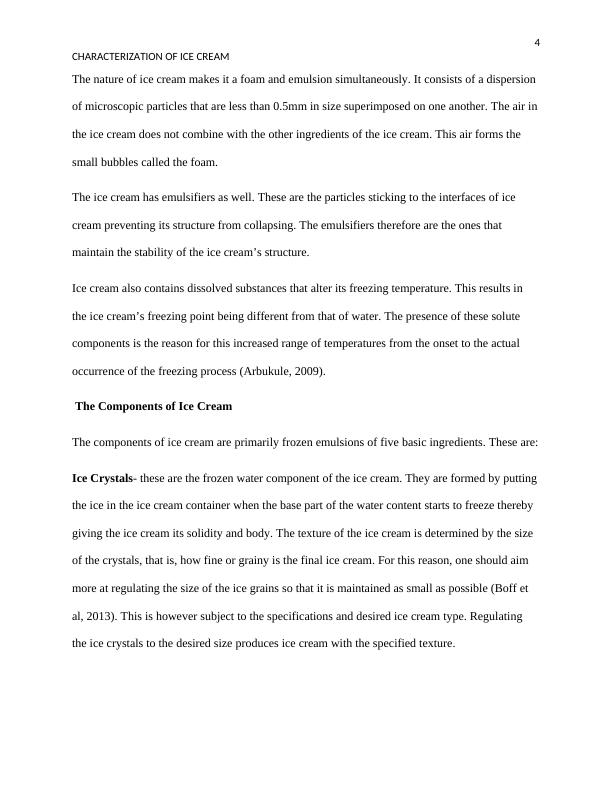
5
CHARACTERIZATION OF ICE CREAM
Air- this is the invisible part of the ice cream. The air plays a big role in the overall nature of the
final ice cream product. The amount of air whipped into the ice cream is represented as the
overrun value of the ice cream.
Ice cream generally has a porous - like structure. The tiny air pores found in the mixture of the
ice components determines the taste, texture and volume of the resultant ice cream. It also
maintains the general consistency of the ice cream. Ice cream varieties with very low overrun
tend to be less tasty as compared to those with higher overrun. However, having overrun that’s
too high decreases the quality of the ice cream. High overrun increases the volume, meaning the
actual amount of ice cream per kilogram of ice cream would be small. Since air is just found
freely and increases the volume of ice, its content in the ice should be reduced, thereby
increasing the quality of the ice cream. Without doing this, the volume of ice cream can increase
to appear as if it’s big yet it is just filled with air bubbles (Cao-Hoang, 2010).
Fat- the fat component of the ice cream is basically provided by the butterfat in the milk. Its
main purpose in the ice cream is to add richness. It also stabilizes the base of the whole ice cream
mixture.
The density of the ice cream is determined by the amount fat in it. Higher amounts of fat
improves the density while lower amounts decrease it. This is dependent on the overrun values
since the volume of air in the ice cream influences its volume.
The milk fat in the ice cream also provides the smooth texture of the ice and improves the flavor
of the ice cream.
Sweeteners, Stabilizers and Emulsifiers- various ingredients for example sugars, syrups or
honey are added to provide the sweetness in the ice cream. Ingredients such as these are
CHARACTERIZATION OF ICE CREAM
Air- this is the invisible part of the ice cream. The air plays a big role in the overall nature of the
final ice cream product. The amount of air whipped into the ice cream is represented as the
overrun value of the ice cream.
Ice cream generally has a porous - like structure. The tiny air pores found in the mixture of the
ice components determines the taste, texture and volume of the resultant ice cream. It also
maintains the general consistency of the ice cream. Ice cream varieties with very low overrun
tend to be less tasty as compared to those with higher overrun. However, having overrun that’s
too high decreases the quality of the ice cream. High overrun increases the volume, meaning the
actual amount of ice cream per kilogram of ice cream would be small. Since air is just found
freely and increases the volume of ice, its content in the ice should be reduced, thereby
increasing the quality of the ice cream. Without doing this, the volume of ice cream can increase
to appear as if it’s big yet it is just filled with air bubbles (Cao-Hoang, 2010).
Fat- the fat component of the ice cream is basically provided by the butterfat in the milk. Its
main purpose in the ice cream is to add richness. It also stabilizes the base of the whole ice cream
mixture.
The density of the ice cream is determined by the amount fat in it. Higher amounts of fat
improves the density while lower amounts decrease it. This is dependent on the overrun values
since the volume of air in the ice cream influences its volume.
The milk fat in the ice cream also provides the smooth texture of the ice and improves the flavor
of the ice cream.
Sweeteners, Stabilizers and Emulsifiers- various ingredients for example sugars, syrups or
honey are added to provide the sweetness in the ice cream. Ingredients such as these are
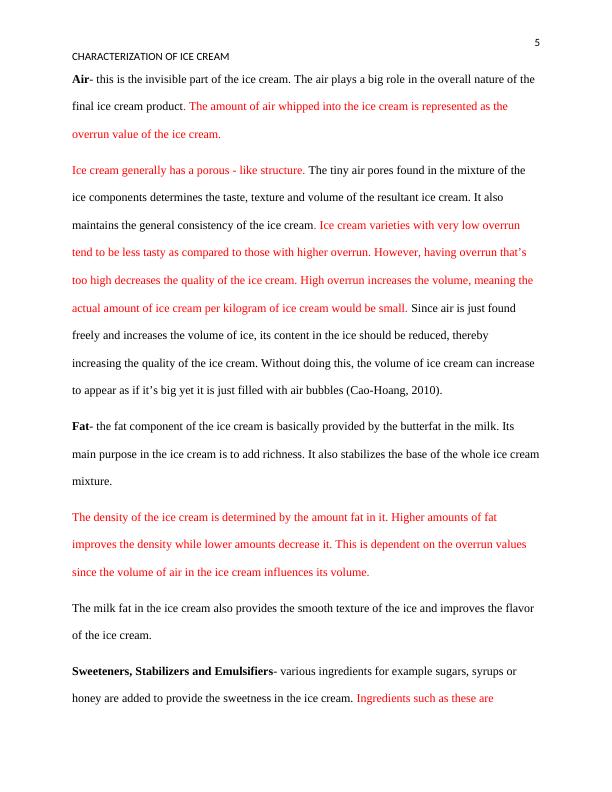
6
CHARACTERIZATION OF ICE CREAM
collectively referred to as sweeteners. The sweeteners affect both the body of the ice cream and
its texture. They also acts as the impurities that alter the freezing point. This ensures that the ice
cream does not freeze resulting in a very hard solid. The stabilizers balances the mixture both
chemically and structurally while the emulsifiers such as proteins help in coalescing the droplets
of fat in the ice cream.
Reducing the sweeteners component of the ice cream therefore can result in a reduced quality of
the ice in terms of the body and the stability of the ice-cream (Carr et al, 2012).
MSNF (Milk Solids Non - Fat) - these include non-fat milk components like proteins and
mineral salts and other flavors. These solids contribute largely to the body and texture of the ice
cream. They also add flavor and sweetness to the overall mix. These solids should be regulated
so that they are not too much nor too little to achieve the required balance for the given ice cream
variety. This contributes to the overall quality and grade of the ice cream.
CHARACTERIZATION OF ICE CREAM
collectively referred to as sweeteners. The sweeteners affect both the body of the ice cream and
its texture. They also acts as the impurities that alter the freezing point. This ensures that the ice
cream does not freeze resulting in a very hard solid. The stabilizers balances the mixture both
chemically and structurally while the emulsifiers such as proteins help in coalescing the droplets
of fat in the ice cream.
Reducing the sweeteners component of the ice cream therefore can result in a reduced quality of
the ice in terms of the body and the stability of the ice-cream (Carr et al, 2012).
MSNF (Milk Solids Non - Fat) - these include non-fat milk components like proteins and
mineral salts and other flavors. These solids contribute largely to the body and texture of the ice
cream. They also add flavor and sweetness to the overall mix. These solids should be regulated
so that they are not too much nor too little to achieve the required balance for the given ice cream
variety. This contributes to the overall quality and grade of the ice cream.

End of preview
Want to access all the pages? Upload your documents or become a member.
Related Documents
Characterization of ice cream Assignment PDFlg...
|14
|3376
|52
